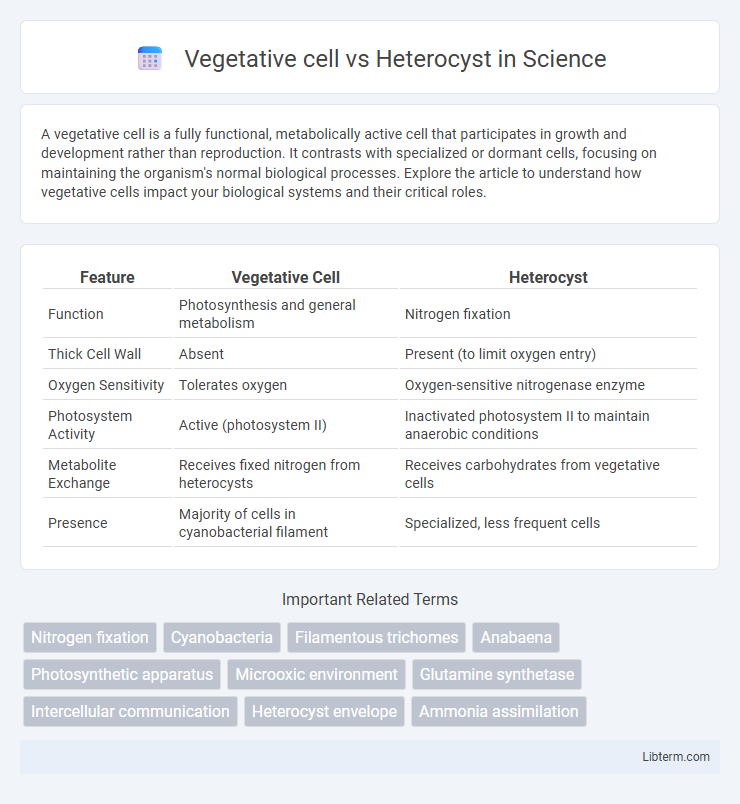A vegetative cell is a fully functional, metabolically active cell that participates in growth and development rather than reproduction. It contrasts with specialized or dormant cells, focusing on maintaining the organism's normal biological processes. Explore the article to understand how vegetative cells impact your biological systems and their critical roles.
Table of Comparison
| Feature | Vegetative Cell | Heterocyst |
|---|---|---|
| Function | Photosynthesis and general metabolism | Nitrogen fixation |
| Thick Cell Wall | Absent | Present (to limit oxygen entry) |
| Oxygen Sensitivity | Tolerates oxygen | Oxygen-sensitive nitrogenase enzyme |
| Photosystem Activity | Active (photosystem II) | Inactivated photosystem II to maintain anaerobic conditions |
| Metabolite Exchange | Receives fixed nitrogen from heterocysts | Receives carbohydrates from vegetative cells |
| Presence | Majority of cells in cyanobacterial filament | Specialized, less frequent cells |
Introduction to Vegetative Cells and Heterocysts
Vegetative cells in cyanobacteria perform photosynthesis and are responsible for growth and energy production, containing thylakoid membranes with chlorophyll. Heterocysts are specialized nitrogen-fixing cells that develop under nitrogen-deprived conditions, featuring thick cell walls to create an anaerobic environment essential for nitrogenase activity. These two cell types collaborate within cyanobacterial filaments, balancing carbon fixation and nitrogen assimilation for optimal survival.
Morphological Differences
Vegetative cells are generally smaller, elongated, and contain numerous thylakoids for photosynthesis, whereas heterocysts are larger, spherical, and possess thickened cell walls to provide a micro-oxic environment for nitrogen fixation. Vegetative cells lack the extensive glycolipid layers found in heterocyst envelopes, which serve as oxygen diffusion barriers. The distinct structural adaptations between these cells reflect their specialized functions within cyanobacterial filaments.
Functional Roles in Cyanobacteria
Vegetative cells in cyanobacteria primarily conduct photosynthesis, converting light energy into chemical energy and synthesizing organic compounds essential for growth. Heterocysts specialize in nitrogen fixation by creating an anaerobic environment necessary for nitrogenase enzyme activity, enabling cyanobacteria to convert atmospheric nitrogen into bioavailable ammonia. These complementary functional roles support cyanobacterial survival in diverse environments by balancing carbon assimilation with nitrogen acquisition.
Nitrogen Fixation Capabilities
Vegetative cells primarily conduct photosynthesis and lack nitrogen fixation capabilities, while heterocysts are specialized cells adapted for nitrogen fixation in cyanobacteria. Heterocysts provide a low-oxygen environment essential for the activity of nitrogenase, the enzyme responsible for converting atmospheric nitrogen (N2) into ammonia (NH3). This functional differentiation enables cyanobacterial filaments to efficiently perform both photosynthesis and nitrogen fixation simultaneously.
Structural Adaptations
Vegetative cells possess thin walls and abundant thylakoid membranes optimized for photosynthesis, enabling efficient light capture and energy conversion. Heterocysts, specialized nitrogen-fixing cells, feature thickened cell walls with glycolipid layers to create a micro-oxic environment essential for nitrogenase enzyme protection. The distinct structural adaptations of vegetative cells and heterocysts facilitate complementary functions within cyanobacterial filaments for photosynthesis and nitrogen fixation.
Genetic Regulation of Cell Differentiation
Vegetative cells and heterocysts display distinct genetic regulation mechanisms for cell differentiation in cyanobacteria. In heterocysts, the hetR gene acts as a master regulator, activating a cascade of nitrogen fixation genes while suppressing photosynthesis-related genes to facilitate specialized function. Conversely, vegetative cells maintain expression of genes involved in photosynthesis and growth, with regulatory networks preventing heterocyst gene activation under nitrogen-replete conditions to preserve cellular differentiation.
Environmental Triggers for Heterocyst Formation
Heterocyst formation in cyanobacteria is primarily triggered by nitrogen deprivation in the environment, specifically the absence of combined nitrogen sources such as nitrate or ammonia. Vegetative cells detect nitrogen limitation, initiating differentiation into heterocysts to facilitate nitrogen fixation under aerobic conditions. This adaptive response ensures survival and metabolic balance in fluctuating nitrogen availability.
Metabolic Pathways and Exchange
Vegetative cells primarily perform oxygenic photosynthesis, fixing CO2 through the Calvin cycle, and generate carbohydrates that diffuse to heterocysts. Heterocysts specialize in nitrogen fixation via the nitrogenase enzyme complex, creating an anaerobic environment by inactivating photosystem II and supplying fixed nitrogen to vegetative cells. Metabolite exchange involves the transfer of sucrose from vegetative cells to heterocysts, while heterocysts export fixed nitrogen compounds like glutamine back to vegetative cells, maintaining metabolic balance in cyanobacterial filaments.
Importance in Ecosystems
Vegetative cells in cyanobacteria perform photosynthesis, producing oxygen and organic compounds essential for aquatic food webs and global carbon cycles. Heterocysts specialize in nitrogen fixation, converting atmospheric nitrogen into bioavailable forms, crucial for nutrient cycling and supporting plant and microbial growth in nitrogen-limited ecosystems. Together, these cell types maintain ecosystem productivity and enhance soil fertility in diverse environments.
Comparative Summary and Future Research Directions
Vegetative cells, responsible for photosynthesis and growth in cyanobacteria, contrast sharply with heterocysts that specialize in nitrogen fixation under aerobic conditions due to their thick cell walls and lack of oxygen-evolving photosystem II. Comparative studies reveal significant differences in gene expression profiles, cellular morphology, and metabolic activities, emphasizing heterocyst differentiation as a complex regulatory mechanism influenced by environmental nitrogen levels. Future research is directed towards unraveling the molecular signaling pathways controlling heterocyst development, optimizing genetic engineering techniques to enhance nitrogen fixation efficiency, and exploring synthetic biology applications for sustainable agriculture.
Vegetative cell Infographic

 libterm.com
libterm.com